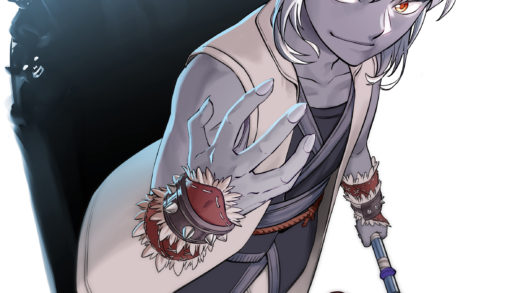
While there are an infinite number of possible stories, the vast majority of them fall into one of four categories. These four “essential” stories are the most basic forms of the stories that humans tell, and by understanding and using them you can quickly put your story into a simple framework that lets you know where your story starts, goes, and finishes. Not only that, knowing these four essential stories lets you weave together more complex stories than just a character doing something and getting a result, and turn it into a story which is layered and satisfying for readers.
So, what are these four essential stories?
They are stories about Milieu, Inquiry, Character, and Event, which you might notice form into the very handy mnemonic of MICE. This is why you’ll often see them referred to as the “MICE Quotient” online as different writing teachers discuss and explain them. The “quotient” part refers to their use in helping new writers understand how to use them to add layers and plot threads to stories, but before you learn about that, you have to understand what each of them is.

Milieu
In a milieu story, a character enters a setting and then either changes that setting or is changed by that setting. Usually, setting refers to a place, but it can also cover things that are part of a setting like plants, animals, peoples, cultures, technology, or anything else. The story starts when the character arrives at the setting, and it ends when either the character leaves or decides to stay in that setting. Often these types of stories are told as a way of exploring a setting with the main character as a window to that setting for the audience.
The Three Acts of a Milieu Story
Act 1 (Setup): The lead character’s environment changes to a new one. Usually, the character goes to a new place, or something is added to a familiar place which changes it into something new to the main character.
Act 2 (Action): The main character adapts themselves to the new environment and faces situations where the character, environment, or both change in some way.
Act 3 (Result): The lead character reaches a point where they can no longer change the world, or it can no longer change them. They must then make a decision whether to stay and be part of the setting or leave based on their own needs or situation.
Sample Milieu Stories:
- A wandering ronin comes into a small farming town where he offers to help with the harvest in trade for a place to stay for the winter until the local lord recruits soldiers the following spring. Through working alongside the farmers, he finds a new purpose in life, and as the winter drags on, he slowly becomes part of the community and finds love with the farmer’s daughter. When spring comes, men from the local lord come into town recruiting soldiers for the lord’s army, but he decides to keep his new life as part of the community and stays to become a farmer. (The soldier entered the milieu, was transformed by it, and chose to stay as part of the community.)
- A student comes to work one day to discover they now have a new teacher. The teacher has a strange an eccentric style of teaching where everything involves acting and creativity. The very practical student doesn’t like this change, but their classmates do, and slowly the practical student comes to appreciate the new classroom environment as they see how the others respond to it. In the end, the practical student is given a chance to transfer to a new school, but decides to stay and explore new sides of themselves. (The student’s milieu was transformed, they adapted to it, and chose to stay part of it.)
- A young office worker is hit by a truck and killed, waking up in a world that resembles a fantasy role-playing game. The world they have entered into is chaotic and filled with demons and monsters. They don’t know why they are there or how to get home and must turn themselves into an adventurer to survive. Through adventuring and making allies, they discover that they were summoned to replace the guardian of a magical tree which is the source of magic energy in the setting. They choose to become the new guardian and take their place with the tree, restoring the dying tree to life and banishing the corrupting influence. (The office worker entered the milieu, saw it was in chaos, adapted to it, and stayed in the new land they became a part of.)
Notes:
- Change to a character through exploring a milieu can be as simple as learning or understanding something that wasn’t understood before. It doesn’t have to be serious and significant character change, but it should feel consequential to the reader.
- Milieu stories can be internal or external. In an internal milieu story the character’s perceptions of the world around them changes and they must adjust to experiencing the world in a new way (“Well, I can see ghosts now. This is new.”). On the other hand, in an external milieu story, the character’s environment changes and they must deal with this new setting (“Where am I? How did I get here?”).
- See the chapter on Exploratory Manga for more details on one type of Milieu story.
Examples of Milieu manga and anime: One Piece, Bakuman, Overlord, Kurosagi, Lone Wolf and Cub, Pokémon, One-Punch Man, Fruits Basket, Ouran Koukou Host Club, Hikaru no Go, Assassination Classroom, That Time I Got Reincarnated as a Slime, So I’m a Spider, So What?, Ascendance of a Bookworm, The Devil is a Part-Timer, Konosuba, Boys Over Flowers, etc.

Inquiry
In a story about inquiry, a character is faced with a question that must be answered and tries to find the answer to that question. The main character may be a detective trying to solve a mystery, or a scientist trying to cure a disease. They might be an athlete who needs to find out if they still have what it takes, or they might be a chef trying to find the perfect soufflé recipe. However it goes, they start the story by being presented with a problem, and at the end of the story the problem will either be solved or they will be forced to give up trying to solve it. Everything that happens in between is linked to their efforts to solve that central problem that drives the story.
The Three Acts of an Inquiry Story
Act 1 (Setup): The main character has a question that for whatever reason (job, curiosity, survival, etc.) must be solved.
Act 2 (Action): Often facing setbacks and challenges along the way, the main character follows the steps they need to answer the question. Everything that happens in the story is somehow linked to the solving of the question or the understanding of the answer to the question.
Act 3 (Result): The main character answers the question or gives up trying to solve it.
Sample Inquiry Stories:
- A man is found dead and a police detective is put on the case. The detective learns that the man was a low-level city clerk who lived along and had no family, so he interviews the clerk’s co-workers and discovers that the clerk had noticed missing money in a bank account and reported it to his boss. Using that information, the detective soon arrests the clerk’s boss for murdering the clerk to try and cover up his theft of the money. (The detective was given a puzzle of who killed the clerk and why, worked through the possibilities, and solved the problem.)
- A mysterious disease is turning people into zombies and a team of researchers race to find a cure for it. While collecting samples, they learn that a village exists where nobody was turned into a zombie despite exposure and race there to find the reason why. Eventually they learn that the zombie virus is cured by an element in the town’s well water and they use that knowledge to cure the zombies and turn them back into humans. (Scientists are faced with a zombie plague, they try to learn how this happened and how to stop it, and eventually find the answer in a small town’s well water.)
- A young office worker is hit by a truck and killed, waking up in a world that resembles a fantasy role-playing game. They learn that the tree of life which powers the world’s magic is dying and nobody can stop it, so they go on a quest to find a solution and save the magic because it’s the only thing that can send them home. In the end, they learn the tree was poisoned by demons and find a way to break the spell so the guardian of the restored tree can send them home. (The young office worker was given the problem of how to save the magical tree of life, searched for a solution, and eventually found it so they were able to return home.)
Notes:
- If the story is a Detective story, usually the problem to be solved is one of three types: why something happened, how something happened, or who was responsible for what happened. (Or some combination of the three.)
- Most stories have Inquiry story threads inside them somewhere, since there are always dramatic questions to be introduced and answered, but a real “mystery” story is only about the question and the hunt for the solution.
- Horror stories are very often Inquiry stories, where the main characters are the victims trying to solve the mystery behind the “monster” before they all die. Usually the “monster” is the result of a “sin” which has left the world unbalanced and the main character(s) need to learn that sin and set it right in order to stop the killings.
- Inquiry stories can be internal or external. An internal Inquiry story means the character is trying to answer a question that has come from within themselves (“Why do I feel this way?”) whereas an external inquiry story is about them trying to answer a question from outside themselves (“Why is my brother acting this way?).
Examples of Inquiry manga and anime: Detective Conan,Dr. Stone, The Promised Neverland, Uzumaki, Ghost Hunt, Liar Game, Steins Gate, Monkey Peak, etc.

Character
In a story about Character, a character struggles with personal change. In this type of story, some inner part of a character changes from what it was before to something different. This change can be as small as deciding they now like vanilla ice cream to completely becoming a totally new person. The key is that they are somehow different than they were before at the end of the story. This change can be good or bad, and may even go between positive and negative before it reaches some final position.
The Three Acts of a Character Story
Act 1 (Setup): An event happens which begins a character’s transformation as a person.
Act 2 (Action): The character faces one or more situations that cause them to confront parts of themselves which prevent them from reaching their goals or becoming their best self.
Act 3 (Result): The character has finally transformed into a different version of themselves.
Sample Character Stories:
- A troubled student is forced to start a new high school when they get kicked out of their old one for fighting all the time. At the new school, they meet a student council president who they clash with right away and the two hate each other. Through a series of events, the two are forced into being together in different situations and slowly come to understand each other. The troubled student slowly comes to realize they need the student council president in their life and must face their own insecurities that make them reject other people. They open up to the president, who returns their affections, and the two start a new relationship together. (The troubled student meets a person who forces them to confront their inner demons if they want to live a better life and changes into a new person so they can be together.)
- A poor young student is hired to become the driver for a rich man. Working as a driver, the student carefully observes how the rich man acts and operates and realizes they have habits which are holding them back in their life. Soon, the student has changed their ways and started an online business and begun to make money they use to pay off their family debts. Eventually, their online business becomes so big they’re able to sell it to the rich man they drove for, and become a rich businessperson themselves who invests in smaller businesses to help others. (The student wants to be rich but doesn’t know how, so they study and learn from the more successful businessman, and then change themselves to be more like their model to succeed.)
- A young office worker is hit by a truck and killed, waking up in a world that resembles a fantasy role-playing game. The office worker was a shy introvert who never stood up for themselves and just tried to get through each day with as little human interaction as possible. However, they find a baby dragon which needs their help and so to help keep the dragon alive they must learn how to interact with the local people. Over a series of adventures with the growing dragon, they become a confident leader who helps the local people overcome a tyrannical lord. In the end, they become the new lord and mentor a new generation of dragon riders. (The shy office worker must find the confidence they need to protect their new dragon partner and ends up becoming a great leader through standing up to the local “boss”.)
Notes:
- In these stories the main character usually starts unhappy with some part of themselves or their life and then a catalyst appears which offers them a chance to change.
- The most common version of this story (when used as the main storyline) is one where the main character knows they need to change in some way but refuses to change and instead does everything they can to avoid changing. Then, when they hit rock bottom at the end of Act 2 (Action), they are forced to change in order to fix the problems their poor choices have created.
- Character change stories usually have a main character and a “guide” who is the one who forces them to face their need to change or who acts as a reason they need to change (or both). This guide doesn’t even need to be a person, just someone or something that acts like a speck of dust in the character’s emotional eye that they can’t get rid of unless they change.
- Romance stories are mostly Character stories where the main character must change themselves or their love interest (or both) to achieve happiness.
- Character stories can also be internal and external. In an internal character story the motivation for change comes from within the character (“I’m unhappy. How do I not be unhappy?”) and in an external character story the motivation for change comes from outside the character (“My boss says unless I learn to be a better salesperson, I’m fired.”).
Examples of Character manga and anime: Naruto, Magu-chan: God of Destruction, Skip Beat, Blue Flag, Anonymous Noise, etc.

Event
In an Event story, external things happen that throw the character’s life out of balance and the main character spends the rest of the story dealing with the repercussions of those events. This event can be as simple as discovering they’re out of food and need to shop, or as complex as trying to survive an alien invasion. The event could be the unexpected result of something the character did or something totally unexpected that was outside the character’s control. Either way, the character now has to deal with the consequences of that event and find a way to adapt and overcome the problem.
The Three Acts of an Event Story
Act 1 (Setup): Something happens to the character which can’t be ignored without consequences.
Act 2 (Action): The character reacts to what happened and tries to find a way to deal with the situation.
Act 3 (Result): The character solves the problem created by the event or finds a new balance in the changed situation.
Sample Event Stories:
- A dying martial artist gives the youngest of his three students the secret techniques that made his martial arts invincible. The two older students attack and try to kill the youngest student who barely manages to escape alive. The youngest student wanders the land while mastering the secret techniques and meeting friends along the way who help him understand the meaning behind martial arts. When the youngest is forced to face the elder students in a tournament, he shows them he has taken the secret techniques to a new level and defeats them. He founds a new school to teach his refined techniques to the next generation.
- A nerdy high school student’s father re-marries and now they’re living with the captain of the school volleyball team. The volleyball star keeps getting into weird situations and the nerdy student keeps being forced to rescue them because of their new family ties. Eventually, the volleyball star and the nerdy student come to an understanding, and accept they’re now family. (The nerdy student is forced into a new family situation, must deal with the events that come with that new family situation, and they find a way to live peacefully in this new situation.)
- A young office worker is hit by a truck and killed, waking up in a world that resembles a fantasy role-playing game. They make friends, discover they have magical powers, and build an alliance of kingdoms based on freedom and justice. With their new allies, they defeat a great demon lord and then settle down with their beautiful love interest in a peaceful and happy land.
Notes:
- Event stories are the “catch-all” story category when the story’s focus isn’t about setting change or character change.
- Even stories can be internal or external. In an internal Event story, the event which causes them to act comes from inside the main character (“I’m hungry, time to find food.”) whereas in an external Event story the driving force for acting comes from outside (“Godzilla is attacking the city!”).
Examples of Event manga and anime: Demon Slayer: Kimetsu no Yaiba,Naruto: Shippuden, Jojo’s Bizarre Adventure, Kaiju No.8, Attack on Titan, Dragonball, BLEACH, Glass Mask, NANA, Fist of the North Star, Tokyo Ghoul, Berserk, Slam Dunk, Death Note, Hunter X Hunter, My Hero Academia, Sakamoto Days, Chainsaw Man, etc.
Now, some of you might have noticed that technically, all four are “event” stories in the sense that they all tend to start with some occurrence (usually called the “inciting incident” by writers) which sets of the chain of events that follow. However, the difference is where each type of story goes after that initial event launches the story into action. In Milieu stories, the inciting incident changes the main character’s environment and makes them adjust to a new situation. In Inquiry stories, the inciting incident presents the character with a question, and that question needs to be answered in some form by the end of the story. In Character stories, the inciting incident triggers a path to character change which the main character will accept or reject in the end. Finally, in actual Event stories, the inciting incident will lead to other events, which will lead to other events, and finally result in a new status quo.
Also, these are meant to be very broad categories, and many stories could in theory fit into multiple categories. However, the trick to finding which type of story is really being told is to look at the Spine of Action for a particular story and what is really happening in the story as a whole. If the story is about conflicting with the world, it’s a Milieu story. If the story is about seeking knowledge, it’s an Inquiry story. If the story is about personal transformation, it’s a Character story. And finally, if the story is about reacting to what’s thrown at the main character, it’s an Event story.
Since most manga are continuing serials, they usually try to avoid stories built around character change since they don’t want the lead character to change much except over long periods of time. Thus, they avoid Character stories when possible and usually stick with Event stories where the main character is thrust into a difficult situation and spends the rest of the series dealing with the ramifications of those initial events. Sometimes, they also tell Milieu stories where the main character enters a strange new world or life situation and the real stars are the people and setting around the main character so the main character doesn’t need to change much. And rarely, they tell Inquiry stories where the main character’s overall goal is to solve some greater problem through solving a bunch of smaller mysteries.

Using the Four Essential Stories in Your Writing
The first thing to understand is that these essential stories are not plots that tell you what happens inside a story, they’re frameworks to help you understand the very rough shape of the story. A good comparison might be the way we think of buildings – instead of Milieu, Inquiry, Character and Event we have Houses, Apartment Buildings, Factories and Stores. Calling something a Milieu story is like calling something a House, it tells us the purpose of the building and the rough shape it will take, but it doesn’t tell us the details. It’s the same with these essential stories, which tell us the very rough shape a story will take but doesn’t tell us any details about it.
To continue the house metaphor – the builder (author) decides they want to make a house (Milieu story) and then they decide whether they want to use pre-planned designs that have worked for other builders (story plots) or make up their own design. Then they will put up the framework (write a story outline) and begin planning out the details of how it will all come together. When they have all their materials (ideas and characters) in place, they will start building (writing) the house and putting it all together.
So, the usual order when using these essential stories is as follows:
Essential Story > Story Structure (Three Act/KSTK) > Story Plot > Details
You figure out your essential story, and that gives you the story structure, which helps you decide what kind of plot you’re going to tell, and then you start to figure out all the plot details.
For example, what if you want to tell a story about a young boy trying to get his younger sister to a shelter in a city that’s just had a major earthquake? Well then, that’s clearly an Event story, so you automatically know that Act One will start before, after, or during the (Event) Earthquake. Act Two will be them trying to get across the disaster zone and the challenges they face. And Act Three will have them arrive at a safe place of some kind.
Now you just have to figure out if you want to use a plot from some other source, or make up your own to help you fill in the details. This story could become a tragedy where the boy is dying and trying to get his sister to safety before he dies. It could be an action story where the boy and girl are being hunted by a group of robbers because they witnessed something they shouldn’t have seen. It could be a comedy where the boy turns the trip into a fun adventure to keep the scared girl calm.
Those are all different plots, and while the MICE story they’re built on helps determine where the story will start and end, it doesn’t tell the writer the details of what happens in between, just helps keep everything organized and on track.
In fact, another good use of the essential stories is to use them to help you figure out what your main story is going to be. You can do this by taking your story idea and trying it out with different MICE stories to see which one is the most appealing to you to write.

For example, let’s use the story idea above about the boy and girl trying to reach safety after a major earthquake.
Milieu Story: The story could be about them adapting to the changed world and figuring out how to survive in the post-earthquake environment. Or maybe they will be viewpoint characters and it’ll be a story about how the different people they meet deal with a disaster situation where society’s rules are out the window.
Inquiry Story: The story could be about them trying to find out why their mother isn’t answering her phone, and so they go on a quest across the city to find their mother and learn if she’s alive or dead.
Character Story: The story could be about the boy having to take responsibility for the first time in his life and learn to use his head instead of fooling around. Or maybe he’s always been jealous of his younger sister and all the attention she gets, but now he comes to realize how precious she is in his life as they journey together.
Event Story: As above, the children could become witnesses to a crime of opportunity being committed which is using the earthquake for cover and become the targets of the criminals trying to eliminate any witnesses.
Each of these could easily become a separate and very different story, and by laying them out like this the writer can see the different story possibilities these characters have and decide which one is the best overall story they want to tell. You can only use one of the four as your main story framework, so choose the one which produces the most exciting and interesting ideas.
Of course, that doesn’t mean the other ideas will go to waste. They can become storylines that still get used inside the bigger story the writer wants to tell…

Why is it also called “the MICE Quotient?”
As mentioned previously, you will usually see these referred to as the MICE Quotient and not as “the four essential stories” in other sources.
Writer Orson Scott-Card, originator of the MICE Quotient, pointed out that long stories are often made of a whole bunch of shorter, smaller stories, and each plot thread or storyline inside a bigger story is also one of these four essential stories. In fact, it’s rare to have a story that’s longer than a few pages that doesn’t have more than one of these essential stories running inside it at the same time. So, a certain percentage (or “quotient”) of a story is actually made-up other smaller storylines that the writer must keep track of and make sure to pay them off in the end.
Let’s look at a generic Isekai story where a person is transported to a fantasy world. In this case, the Character story about the shy introvert who finds a baby dragon after they arrive in a new world.
The main overall story is a Character story where the hero learns to be brave and fight for what they believe in, however, there will be a number of other storylines running inside that overall story. Here are just a few of the possible other stories layered inside the main one at the start of the story.
- A Milieu story about the main character learning to survive in the forest where they wake up at the start.
- An Event story about the character finding a baby dragon and freeing it from a trap set by hunters without being attacked by the scared and angry young dragon.
- A Character story where the baby dragon learns to trust the main character.
- An Inquiry story where the main character needs to figure out what baby dragons eat.
- An Event story where the hero has to venture out to find something for himself and the dragon to eat.
- A Milieu story about the main character trying to interact with the townsfolk from the nearby village and figure out how to trade with them.
Each of these can be their own small chapter of the story, or they can be intermixed with each other and happening across many chapters and scenes at the same time. Everything the character does is either a reaction to something (Event), someone struggling with personal change (Character), them getting used to the setting (Milieu), or them trying to find the answer to a question (Inquiry). And these can be long stories that run throughout the whole greater story, or something so small and short it’s over in a few sentences.
For most writers, trying to keep track of all the different MICE stories inside a novel or long work would be too much and require a lot of book-keeping. However, you don’t need to keep track of all of them, just the important ones that make up the major threads of your story. Such as the different Character plotlines for the main character and any supporting characters, Inquiry stories for the mysteries that pop up during the story, and the major Event stories that come from what happens in the overall story to the main characters and others.
If you want to know more about the MICE Quotient, look up Mary Robinette Kowal’s website, as she’s one of its strongest proponents and has videos and examples there about how she uses it and others can as well.

